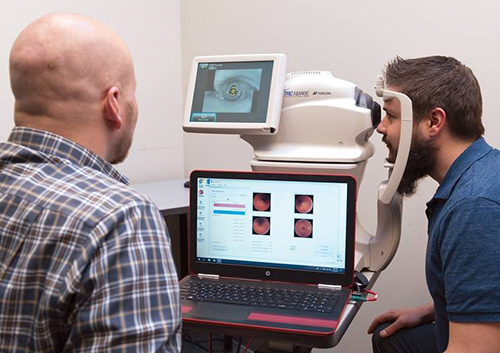FDA clearance of a cloud-based, AI system capable of diagnosing diabetic retinopathy using retinal images highlights the potential for deep learning and algorithmic analysis to assist and, in some cases, replace diagnosticians in medical tests
While clinical laboratories and anatomic pathologists have seen an increasing amount of research and concepts related to artificial intelligence (AI) for diagnostic purposes, few technologies have reached a point where they are ready for clinical applications.
However, the FDA’s recent clearance of the IDx-DR AI diagnostic system from IDx Technologies Inc. of Coralville, Iowa, through the De Novo premarket review pathway, illustrates how image-based AI systems might one day help clinicians, anatomic pathologists, and other care providers diagnose disease and guide therapy decisions.
Already in use at University of Iowa Hospitals and Clinics (UIHC), the device uses cloud computing and algorithms to “autonomously analyze images of the retina for signs of diabetic retinopathy,” according to the IDx website.
This allows IDx-DR to provide a screening decision roughly 20 seconds after image capture.

The IDx-DR system (above) delivers a binary result. When signs of diabetic retinopathy are present, the system recommends a follow-up with an ophthalmologist. If it detects no signs of the condition, the system recommends a follow-up screening in one year. All of this happens without input from a clinician or the services of a medical laboratory. (Photo copyright: Modern Healthcare.)
In a clinical study involving 900 participants published in Nature, a similar AI system achieved 87.2% sensitivity and 90.7% specificity in the detection of diabetic retinopathy, exceeding pre-specified primary endpoint goals.
“AI tools can help physicians handle a lot more data a lot more quickly and help them prioritize,” Susan Etlinger, an industry analyst with the Altimeter Group, told Modern Healthcare. “Theoretically, that could give a family physician a lot more tools in [his/her] toolbox to be able to run an initial diagnostic on somebody and then refer that person for additional treatment.”
Full Integration Shows Promise for Streamlining AI and Diagnostics Workflows
The ability to reach a diagnosis without a clinician already holds potential to drastically impact the workflows and services of medical laboratories and other diagnosticians. However, IDx Technologies also showed how AI might influence data interfacing, while explaining to Modern Healthcare how they have integrated IDx-DR with the electronic health record (EHR) systems of UIHC.
“No one has ever integrated a diagnostic system where there’s no human involved,” noted Michael Abramoff, MD, PhD, Chief Executive Officer and founder of IDx. “We’re ramping up slowly because we want to make sure we work out all the kinks with the EHR and the workflow.”
Once the AI system analyzes images captured by a Topcon TRC-NW400 non-mydriatic retinal camera, results are then automatically communicated to an EHR using Health Level-7 (HL7) interfacing. The entire process is automated once the image is captured.
“The general advantages of AI include automation of certain tasks. This automation allows for increased scale, i.e. increased access, to a service. For systems like IDx-DR, it also allows talent to shift focus to other high priority areas.” Maia Hightower, MD, Chief Medical Information Officer and Chief Population Health Officer for University of Iowa Healthcare, told Digital Journal. “Healthcare is an industry where there is a critical shortage of key talent including medical assistants, nurses, and physicians. AI helps to detect both operational and clinical high-risk areas so that limited resources can be targeted to areas of highest need or greatest return.”
The process used by UIHC highlights potential benefits for medical laboratories as AI continues to impact diagnostic workflows and information processing. The ability to streamline workflows and offload repetitive tasks to automation or AI could allow skilled laboratory workers to further focus on diagnosing complex or difficult cases.

“Due to the highly robotic nature of the camera and the fully autonomous diagnosis, virtually anyone in a healthcare setting can be trained to operate IDx-DR,” Ryan Amelon, PhD, Director of Research and Development at IDx told Digital Journal. “The result is displayed to the user in under a minute or inserted directly into the EMR. The entire patient experience is roughly five minutes.” (Photo copyright: LinkedIn.)
Applying AI to More types of Medical Diagnoses
In an editorial published in NPJ Digital Medicine, Pearse Keane, MD, a clinician scientist at the National Institute for Health Research (NIHR) in the UK, and Eric J. Topol, MD, Director of the Scripps Translational Science Institute (STSI) and Executive Vice President at Scripps Research Institute, posted questions concerning the IDx-DR system and its FDA clearance.
According to Healthcare IT News, key concerns includes:
- A relatively small sample size to determine diagnostic accuracy;
- The ability of clinics to incorporate retinal screening into their practices; and,
- The ability for IDx-DR to detect diabetic neuropathy when patients present other more severe retinal conditions.
Despite these concerns, Keane and Topol note, “While it is always easy to be critical of studies that forge new ground, it is important to applaud the authors for this pivotal work.”
For anatomic pathology laboratories, the IDx-DR system represents a proof of concept that AI and deep learning can analyze medical images—in this case, retinal photographs—and work alongside or in place of trained professionals to make decisions and guide the diagnosis process. How long before similar AI diagnostic systems find their way into clinical laboratories?
“Although deep learning will not be a panacea, it has huge potential in many clinical areas where high dimensional data is mapped to a simple classification and for which datasets are potentially stable over extended periods,” Keane and Topol concluded in their editorial. “As such, it will be incumbent on healthcare professionals to become more familiar with this and other AI technologies in the coming years to ensure that they are used appropriately.”
—Jon Stone
Related Information:
AI Alone Now Making the Diagnosis
With an Eye to AI and Autonomous Diagnosis
AI Diagnostic Tool Plows through FDA Clearance, But Some Experts Not Convinced
New AI System That Tests for Diabetic Eye Disease
University of Iowa Healthcare Rolls Out First Autonomous AI Diagnostic System Cleared by the FDA
FDA Greenlights Tool for Automated Detection of Diabetic Retinopathy in Primary Care
The FDA Just Opened the Door to Let AI Make Medical Decisions on Its Own
AI Can Deliver Specialty-Level Diagnosis in Primary Care Setting
U.S. FDA Approves AI Device to Detect Diabetic Eye Disease




In the future it is becoming increasingly clear that technologies like the artificial intelligence, deep learning and big data and many more will disrupt the way we work today.
It is therefore important that today’s workforce upscale in order to leverage these technologies.
As time goes on we would continue to see that the combination of technology and humanity will create bigger and better results in our workplace and can increasingly help us to reach new result levels.